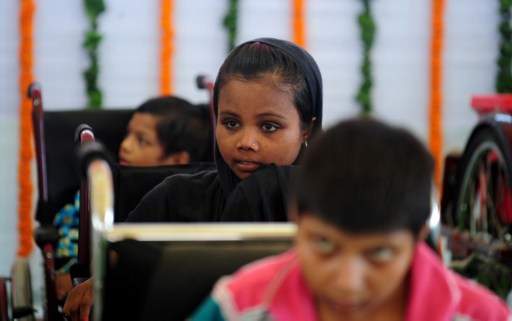Bhubaneswar / 02 de noviembre de 2016 / Por: Diana Sahu / Fuente: http://www.newindianexpress.com/
Enrolment of children with special needs in government schools continues to be dismal in Odisha but, when it comes to disabled girls, the scenario is even more disappointing.
Only two per cent of disabled children are in schools and 0.5 to 0.6 per cent of them comprise girls. Worse, the percentage has not changed in the last one decade. Even as both State and Central Governments have been stressing on mainstreaming girls with special needs in regular schools under the Sarva Shiksha Abhiyan (SSA), their inclusion has not been effective so far.
At least 74,805 disabled children are enrolled in Class I to V (primary) of which, 30,641 are girls (0.69 pc); there are 40,243 students in this category in Class VI-VIII (upper primary) and 17,165 of them are girls (0.74 pc), as per the 2014-15 report prepared by National University of Educational Planning and Administration (NUEPA).
At the same time, there are 42,23,628 general students in Class I to V and 21,62,855 students in Class VI to VIII. While the total number of disabled girls in schools from Class I to VIII is 47,806, there are 30,89,318 general girls in schools in the same class bracket.
In 2013, the enrolment figure of handicapped boys at primary level was 52,770; 22,736 in upper primary and 5208 in secondary level. Similarly, 34,477 girls enrolled in primary schools, 17,302 in upper primary and 4,367 in secondary schools. The figures are a pointer to the fact that a lot many disabled girls drop out of schools before they reach the secondary education system.
Reasons are not far to seek. Lack of accessibility, congenial learning environment, discrimination and communication barriers are some of the factors to blame. Education activists say though the Right to Education Act 2009 talks of girl children, it has not recognised the multiple discrimination faced by disabled girls. None of the education policies speak about need of focus on disabled girls within the education system.
The State has 1,201 Special Primary Schools for Children with Disabilities (CWD), 685 Special Upper Primary Schools and 212 Special Secondary Schools that are run by the School and Mass Education (S&ME) Department. A lot many general schools do have ramps for wheel-chair bound students but that is all that they have for the convenience of disabled students.
As many as 95,493 primary schools have ramps while the number is 49,001 in case of upper primary and 6,443 in secondary schools. What makes the situation worse is that the State does not have adequate number of trained teachers to teach CWDs.
Apart from the S&ME Department run schools, there are 92 special schools that are under jurisdiction of the Department of Social Security and Empowerment of Persons with Disabilities. While 51 of them are funded by State Government, the rest get financial aid from the Centre.
There are total 7,821 handicapped students enrolled in these schools and of them, just 2,355 are girls. These schools are opened by NGOs who seek financial help from the Government to run them. Asha Hans, a city-based disability activist, said most of the girls with mild intellectual disability are enrolled in general schools at the initial stage of their educational career, but after a few years, they drop out due to no or very slow progress.
Since 2010, rules of promotion in school system were changed to grade system. The formal examination system till Class X has also been abolished, but this has not helped educationally empower girls with disabilities. The girl child may not be able to cope with school curriculum as there is little support system, but she is promoted to next class every year. When she faces the board examination, the girl fails to clear the test or clears it with very low marks.
“Girls with intellectual disability are slow learners. When they are admitted to general schools, they fail to do even simple classroom activities like opening a book or the school bag. When other students go outside for games or library, they are left out. Thus, they grow up to be introvert and aggressive due to frustration. Not all schools have special educators to look after these girls,” she said.
Toilets for girl students are an important provision under Right to Education Act to be provided in all schools. However, toilets for disabled girls do not exist in a majority of schools. In fact, one of the major reasons behind drop-out rate of disabled girls in rural areas is that either there are no toilets or if any, they are inaccessible. Hence, the girls end up getting urinary infection and cannot change when menstruating.
Fuente noticia: http://www.newindianexpress.com/states/odisha/2016/nov/01/less-than-one-percent-disabled-girls-entering-schools-in-odisha-1533907–1.html







 Users Today : 144
Users Today : 144 Total Users : 35403117
Total Users : 35403117 Views Today : 174
Views Today : 174 Total views : 3332347
Total views : 3332347